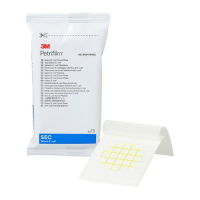3
(English)
EN
1. Use appropriate sterile diluents: Buttereld’s phosphate buered dilution water
5
, 0.1% peptone water
5
, peptone salt
diluent
6
, buered peptone water
6
, quarter-strength Ringer’s solution
6
, dipotassium hydrogen phosphate
6
, saline
solution (0.85-0.90%), bisulte-free letheen broth or distilled water.
See section “” for specic requirements.
If citrate buer is indicated in the standard procedure, substitute with one of the buers listed above,
warmed to 40-45°C (104-113°F).
2. Blend or homogenize sample.
3. For optimal growth and recovery of microorganisms, adjust the pH of the sample suspension to 6.5 - 7.5. For acidic
products, adjust the pH with 1N NaOH. For alkaline products, adjust the pH with 1N HCl.
Plating
1. Place the 3M Petrilm SEC Plate on a at, level surface.
2. Lift the top lm and with the pipette perpendicular to the inoculation area dispense 1 mL of sample suspension onto
the center of bottom lm.
3. Roll the top lm down onto the sample to prevent trapping air bubbles.
4. Place the 3M™ Petrilm™ Spreader with the at side down on the center of the 3M Petrilm SEC Plate. Press gently
on the center of the 3M Petrilm Spreader to distribute the sample evenly. Spread the inoculum over the entire 3M
Petrilm SEC Plate growth area before the gel is formed. Do not slide the 3M Petrilm Spreader across the lm.
5. Remove the 3M Petrilm Spreader and leave the 3M Petrilm SEC Plate undisturbed for at least one minute to
permit the gel to form.
Incubate 3M Petrilm SEC Plates in a horizontal position with the clear side up in stacks of no more than 20 plates.
Incubate 3M Petrilm SEC Plates 24 hours ± 2 hours at 42ºC ± 1ºC. Several incubation times and temperatures can
be used depending on current local reference methods, some of which are listed in the section below titled “
”.
Interpretation
1. 3M Petrilm SEC Plates can be counted using a standard colony counter or other illuminated magnier. Do not count
colonies on the foam dam since they are removed from the selective inuence of the medium. Do not count artifact
bubbles that may be present. E. coli produce dark green to light-green colonies. Colonies may have gas bubbles
associated with them. Count all green to blue-green colonies as E. coli whether there are gas bubbles present or not.
W WARNING
E. coliE. coli O157 strains are
interpreted as E. coli
2. The circular growth area is approximately 20 cm
2
. Estimates can be made on 3M Petrilm SEC Plates containing
greater than 150 colonies by counting the number of colonies in two or more representative squares and
determining the average number per square. Multiply the average number by 20 to determine the estimated count
per 3M Petrilm SEC Plate.
3. When colonies are present in large numbers, 3M Petrilm SEC Plates will cause the entire growth area to become
gray or blue and either or both of the following characteristics: many small, indistinct colonies and/or many gas
bubbles. When this occurs, record results as too numerous to count (TNTC). When an actual count is required, plate
at a higher dilution.
4. Where necessary, colonies may be isolated for further identication. Lift the top lm using proper testing technique
and pick the colony from the gel. Test using standard procedures.
5. If the 3M Petrilm SEC Plates cannot be counted within 1 hour of removal from the incubator, they may be stored for
later enumeration by freezing in a sealable container at temperatures lower than or equal to negative 15°C (5°F) for
no longer than one week.
For further information refer to the “3M™ Petrilm™ Select E. coli Count Plate Interpretation Guide.” If you have
questions about specic applications or procedures, please visit our website at www.3M.com/foodsafety or contact
your local 3M representative or distributor.

